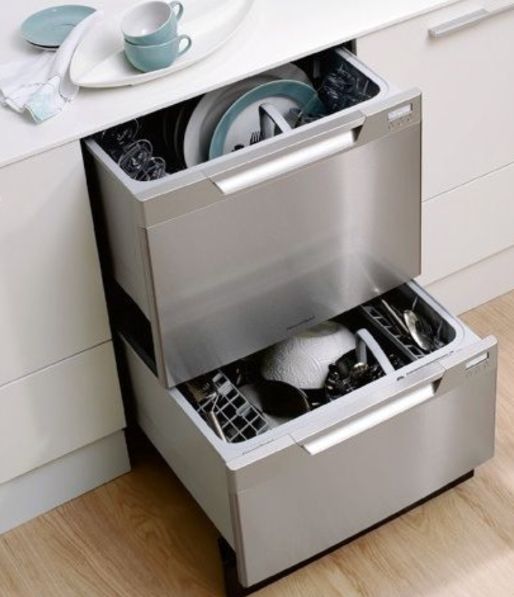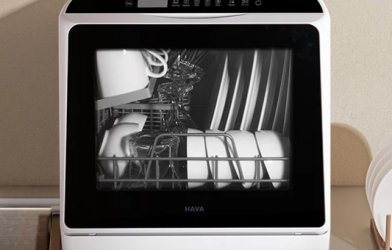Subtotal $0.00
Choosing the right dishwasher for your kitchen can be tricky, especially when you’re deciding between a traditional built-in model and a sleek, modern drawer dishwasher. While both options do the job of getting your dishes sparkling clean, there are distinct differences that might make one better suited for your needs. Let’s explore the key features of each to help you determine the best choice for your home.
What is a Built-In Dishwasher?
The built-in dishwasher is the most common type found in homes. Installed under your kitchen counter, it integrates seamlessly with your cabinetry for a clean, streamlined look. Built-in dishwashers are designed to be permanent fixtures, connecting directly to your home’s plumbing and electrical systems.
Advantages of Built-In Dishwashers:
- Larger Capacity: Ideal for larger families or households that generate more laundry. Built-in models can hold a greater volume of dishes, including larger items like pots and pans.
- Seamless Design: They are designed to blend in with your kitchen, offering a cohesive and sophisticated look.
- Variety of Models: You can choose from a wide range of built-in dishwashers, from basic to high-end models that come with advanced features.
What is a Drawer Dishwasher?
Drawer dishwashers are a newer innovation, offering a more compact and flexible alternative to built-in models. These dishwashers open like a drawer rather than a traditional door. Available in single or double drawer configurations, they provide a more ergonomic and efficient way to load and unload dishes.
Advantages of Drawer Dishwashers:
- Flexibility: Drawer dishwashers allow for small loads to be run independently. Double-drawer models can handle two separate loads at once, which is perfect for smaller households or those with occasional dishwashing needs.
- Ergonomics: The pull-out design eliminates the need to bend over, making it easier to load and unload dishes.
- Energy Efficiency: Drawer dishwashers are particularly efficient when running smaller loads, as they use less water and energy compared to full-sized models.
Key Differences Between Built-In and Drawer Dishwashers
- Design and Installation:
- Built-In Dishwashers: These are installed under the counter and often require professional installation. They are integrated into the kitchen’s cabinetry for a uniform look.
- Drawer Dishwashers: These offer more flexibility in terms of installation and can be placed in different configurations. They are easier to install compared to built-in dishwashers.
- Capacity and Flexibility:
- Built-In Dishwashers: With larger capacities, built-in models are better suited for big families or those who entertain often. They can handle bulky items and bigger loads.
- Drawer Dishwashers: Perfect for smaller households or those who prefer running smaller loads. They also allow you to run two separate loads simultaneously in a double-drawer setup.
- Ease of Use and Accessibility:
- Built-In Dishwashers: Standard models require bending down to load and unload, which might be uncomfortable for some.
- Drawer Dishwashers: With the pull-out design, drawer dishwashers offer a more ergonomic solution, reducing strain and improving accessibility.
- Energy Efficiency and Water Usage:
- Built-In Dishwashers: These are generally more efficient for large loads, using water and energy wisely to handle more extensive cleaning tasks.
- Drawer Dishwashers: More suitable for smaller, frequent loads, reducing overall energy and water consumption by running just one drawer when needed.
Performance Features
Both built-in and drawer dishwashers come with advanced features, ensuring excellent cleaning performance:
- Wash Cycles: Both types offer various cycles, including normal, heavy, and eco-friendly options. Some models, like the Amana Dishwasher with a Triple Filter Wash System, effectively clean away food debris.
- Sanitize Cycle: Both models often feature a sanitize cycle, which uses high temperatures to kill bacteria and germs.
- Dry Cycles: Most dishwashers offer drying options that speed up the drying process, ensuring your dishes are ready to put away.
- Quiet Operation: Modern dishwashers are designed to operate quietly, making them suitable for open-plan living spaces.
Maintenance and Durability
- Built-In Dishwashers: Generally more durable with fewer moving parts, these dishwashers are built to last and require less frequent maintenance.
- Drawer Dishwashers: While they are easy to clean, drawer dishwashers have more moving components, which might mean they require more frequent servicing.
Cost Considerations
- Initial Purchase Price: Built-in dishwashers come in a wide range of prices, from affordable to high-end luxury models. Drawer dishwashers tend to be more expensive per unit of capacity, although they offer convenience and efficiency.
- Installation and Maintenance Costs: Built-in models may require professional installation, which can add to the upfront cost. Drawer dishwashers are usually easier to install, reducing installation costs but may come with higher long-term maintenance costs.
Which Dishwasher is Right for You?
When deciding between a built-in or drawer dishwasher, consider these factors:
- Household Size and Laundry Needs: Larger families or those with frequent laundry needs will benefit from the capacity of built-in dishwashers, while smaller households might prefer the convenience of drawer dishwashers.
- Kitchen Layout: Built-in dishwashers require standard under-counter space, while drawer dishwashers offer more flexibility in installation, fitting into spaces that might be tricky for traditional models.
- Budget and Long-Term Costs: Consider your budget for the initial purchase as well as future maintenance and energy costs. While drawer dishwashers may have a higher upfront cost, they offer energy efficiency for smaller loads, which could save you money in the long run.
Conclusion
Both built-in and drawer dishwashers offer great features, but which one is best for you depends on your specific needs. Built-in dishwashers are perfect for larger households and those who need a high-capacity, seamless kitchen design. Drawer dishwashers are ideal for smaller households, frequent small loads, and those who want flexibility in their kitchen setup. Either way, you’ll find a dishwasher that makes your life easier, so consider your priorities and choose the model that fits your lifestyle.












